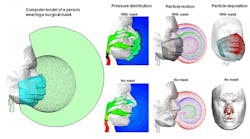Question: Is it better to wear a mask than not wearing one at all?
Answer: That depends on the mask.
When researchers at the University of Massachusetts Lowell and California Baptist University examined the effect of wearing a three-layer surgical mask on inspiratory airflows—and the mask’s effects on inhalation and deposition of ambient particles in the upper respiratory airways—the results were noteworthy. An examination of the deposition of ambient particles of air in the upper respiratory airways showed that the effectiveness in reducing viral loads in the respiratory tract is unclear.
The objective of the study was to numerically characterize the difference in the deposition distribution of ambient aerosols in the upper airway with and without a mask.
“It is natural to think that wearing a mask, no matter new or old, should always be better than nothing. Our results show that this belief is only true for particles larger than 5 micrometers, but not for fine particles smaller than 2.5 micrometers,” said author Jinxiang Xi.
The study, published in Physics of Fluids (AIP Publishing), found that wearing a mask significantly distorts the airflow and aerodynamics near the face, which alters the inhalability of ambient particles in comparison to not wearing a mask. Moreover, they reported that wearing a mask with low (less than 30%) filtration efficiency can be worse than without.
The researchers developed a computational mask–face-airway model that consisted of a pleated surgical mask, a face model and an image-based upper airway geometry. Using numerical methods to track the particles through the mask, they examined the behavior of aerosols passing through the mask; onto the face; into the airway; and, eventually, where they deposit in the nose, pharynx or deep lung.
The researchers were interested in the dosimetry difference with and without a mask across specific areas of the body (the face, upper airway and lungs) and among the four sections of the upper airway (the nose, mouth, pharynx and larynx). In particular, the viral load in the nose was examined with and without a mask.
What they found was that wearing a mask changes the airflow around the face. Air enters the mouth and nose through the entire mask surface, but at lower speeds. Without a mask, air flows into the mouth and nose through specific paths.
The effect of flow rate was important, too. Typically, the same volume of air will be inhaled, whether a mask is worn or not. But due to resistance introduced by the mask, the speeds of both airflow and particles decreased in the typical respiration zones—that is, the region surrounding the mouth and nose when no mask is worn. Airflow and particles redistribute to regions other than these respiration zones of the mask.
The researchers said airflow overall slows down near the face, “which favors the inhalability of particles into the nose, as well as their subsequent deposition in the upper airway.” They also found that airflow speeds are higher near the folds or pleats of the mask; this factor may indicate that mask shape and structure could have an impact on its protective efficacy.
The filtration efficiency of the three-layer surgical mask can vary from 65% (if new) to 25% (when used), noted the researchers. That means that wearing a 65% mask properly will provide good protection, but wearing a 25% filtration mask can be worse than not wearing one at all.
The researchers’ summarized list of specific findings are as follows:
- Wearing a mask significantly slows down inspiratory flows and extends respiration zones, which favors the inhalability of ambient aerosols into noses.
- High-flow speed and elevated particle concentrations are observed in the mask pleats.
- Wearing a mask significantly reduces particle penetration into the lungs, regardless of the filtration efficiency of the mask. Wearing a 65%-filtration mask can reduce lung deposition by three folds for particles of size 1 µm-10 µm.
- With a 65% mask filtration efficiency that is typical for a three-layer surgical mask, deposition is reduced by wearing a mask for all particle sizes considered, except 1 µm-3 µm, for which equivalent dosimetry in the upper airway was predicted.
- Wearing a mask protects the upper airway (particularly the nose and larynx) best from particles larger than 10 µm, while it protects the face and lungs best from particles less than 10 µm (PM10).
- The mask protection of the nasal airway, whose goblet secretory cells are binding sites for SARS-CoV-2, decreases at lower inhalation flow rates (15 l/min or less).
The bottom line? Wearing a mask reduces particle penetration into the lungs, regardless of the filtration efficiency of the mask. A word of advice: Choose an effective mask for the highest protection. It will help mitigate the community spread of COVID-19, Xi said.
About the Author

Rehana Begg
Editor-in-Chief, Machine Design
As Machine Design’s content lead, Rehana Begg is tasked with elevating the voice of the design and multi-disciplinary engineer in the face of digital transformation and engineering innovation. Begg has more than 24 years of editorial experience and has spent the past decade in the trenches of industrial manufacturing, focusing on new technologies, manufacturing innovation and business. Her B2B career has taken her from corporate boardrooms to plant floors and underground mining stopes, covering everything from automation & IIoT, robotics, mechanical design and additive manufacturing to plant operations, maintenance, reliability and continuous improvement. Begg holds an MBA, a Master of Journalism degree, and a BA (Hons.) in Political Science. She is committed to lifelong learning and feeds her passion for innovation in publishing, transparent science and clear communication by attending relevant conferences and seminars/workshops.
Follow Rehana Begg via the following social media handles:
X: @rehanabegg
LinkedIn: @rehanabegg and @MachineDesign

